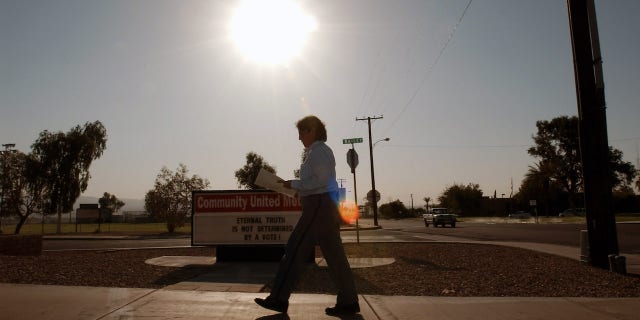North Texas postal worker Eugene Gates Jr., 66, died on June 20 after he collapsed while delivering mail amid a dangerously high heat index, according to multiple reports — and now United States Postal Service (USPS) shifts in Texas will be starting earlier.
Postal workers said a flyer and alerts informed them their shifts would be moved to start at 7:30 in the morning, Fox 4 reported on Tuesday afternoon.
The heat index the day the worker died reached 115 degrees Fahrenheit, the highest recorded temperature in the Dallas-Fort Worth area since 1980, according to a local news outlet.
SWELTERING TEXAS HEAT WAVE SCORCHES SOUTHERN CITIES, BRINGING TRIPLE-DIGIT TEMPERATURES

North Texas postal worker Eugene Gates Jr., 66, died on June 20 after he collapsed in a yard while delivering mail amid a dangerously high heat index. (iStock)
“America’s letter carriers often work in dangerous environments,” National Association of Letter Carriers President Brian L. Renfroe, based in Washington, D.C., said in a recent statement.
“The most important and immediate step that can be taken to protect anyone from the hazard of excessive heat is to learn as much as possible about this potentially life-threatening hazard — particularly the warning signs of heat illness,” he continued.
HEAT WAVE RESPONSIBLE FOR MULTIPLE DEATHS ACROSS US
What’s the heat index?
The heat index measures how hot your body feels when considering both the humidity and the outside temperature, according to the National Weather Service.

“America’s letter carriers often work in dangerous environments,” National Association of Letter Carriers President Brian L. Renfroe, who is based in Washington, D.C., said in a recent statement. (iStock)
When it gets too hot outside, the body starts to sweat, which has a cooling effect when perspiration starts to evaporate.
As the relative humidity increases, however, it takes longer for the sweat to evaporate, causing people to feel warmer.
“Symptoms manifest as an elevated heart rate (tachycardia), sweating, nausea/vomiting, headache, weakness and dizziness,” he noted.
Some other warning signs include feeling thirsty, sweating profusely or having a decreased urine output, the CDC said.
Symptoms of heat exhaustion include elevated heart rate, sweating, nausea, vomiting, headache, weakness and dizziness.
When heat exhaustion symptoms are ignored, they can progress to heat stroke, Allamby warned.
If symptoms worsen, persist for more than one hour or lead to vomiting, it’s important to seek immediate medical attention, the CDC warns.
Signs of heat stroke
Heat stroke is the most serious heat-related illness. It occurs when the body’s sweating mechanism breaks down and the person can’t cool down, according to the CDC.
This condition occurs more often in children and the elderly, who may not have a structured environment to protect themselves from the heat, the doctor added.
Heat stroke “is usually fatal if not treated — but even with treatment, a significant amount of people will die as a result,” Allamby warned.
CLICK HERE TO SIGN UP FOR OUR HEALTH NEWSLETTER
“Time is of the essence, and the earlier treatment starts, the better the chance of survival and recovery,” he added.
The most effective treatment for heat stroke is immersion in a cold-water bath, Allamby said.
“I hope this story helps to remind us to watch out for those who are most vulnerable to heated environments such as this mail carrier, children — especially during the sports training season — and the elderly,” he said.
“Please check on your neighbors and the ones you love — and maybe you can save a life.”

